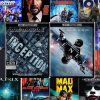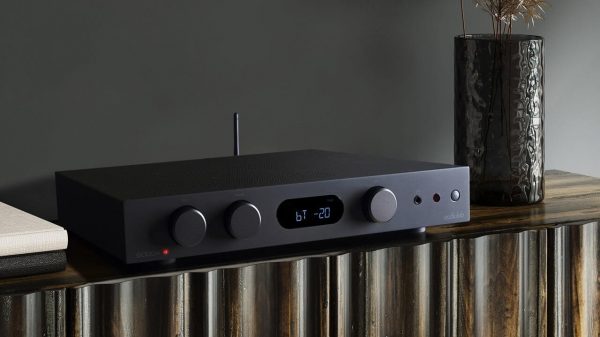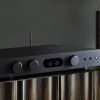Products like the Audiolab 6000A are the future of consumer audio in the home and what makes them more attractive is a comprehensive feature set and affordability. Consumers want fewer boxes.
The changes in digital music streaming have made integrated amplifiers that offer DACs that can support lossless and hi-res streaming that much more important and while some audiophiles will balk at products that don’t support MQA or DSD, the reality is neither format moves the needle for 99% of music listeners and one could always add an external DAC if the two formats are that important to them.
Hi-res music represents less than 10% of the available music on any current platform like Qobuz or Tidal and with Apple Music and Spotify HiFi offering lossless or 24-bit/48kHz – it’s rather silly to focus on such a small amount of music.
Support for wireless streaming has also become a standard feature on many integrated amplifiers, including Bluetooth aptX and aptX HD. Both formats are lossy but sound quality has taken a huge jump recently when streaming from your smart device to an integrated amplifier. Many integrated amplifiers now include USB and Ethernet connectivity for external digital streamers or if you use your desktop computer or laptop as your digital source.

The 6000A falls one level below Audiolab’s 8300A integrated amplifier ($1,299.99) and while it may not offer as much power as its more expensive sibling (50 watts/channel into 8 ohms vs 75 watts/channel into 8 ohms), the 6000A offers a moving magnet phono stage, headphone amplifier, and more impressive ES9018 Sabre32 Reference chip in its internal DAC section. The 6000A’s digital section accommodates 4 digital sources (2 x Toslink, 2 RCA coaxial) making it compatible with Audiolab’s 6000CDT CD transport, and other digital streamers and CD players.
Build quality is first-rate on the 6000A which is offered in matte black or bright silver finishes. The one-piece metal construction is very robust (the 6000A weighs 17.2 pounds) and there is no question that the unit is designed to last.

The front controls; which are also machined out of aluminum complete the rather minimalist look of the 6000A but also serve a multitude of purposes. The 6000A operates as an integrated amplifier out-of-the-box, but the Mode function allows you to use it as a dedicated pre-amplifier or power amplifier giving the user some long-term upgrade options.
The 6000A also allows you to adjust the channel balance, activate an Auto Turn-off timer so that the unit shuts itself down after not receiving a signal for 20 minutes, and the ability to play with 3 digital filters (Fast Roll-off, Slow Roll-off, and Minimum Phase) which do impact the sound.
The 6000A did not get overly warm during many hours of continuous playback and its robust build quality inspires confidence.

Looking though my listening notes, what stood out with almost every single recording was the 6000A’s remarkable transparency. The 6000A’s sense of drive, and detail retrieval is not what one normally expects at this price point and that it achieves such a high level of playback quality without ever sounding too strident or forward is a huge positive.
Horns, in particular, have a healthy degree of bite and tone making them a vibrant listen with great jazz recordings like Hank Mobley’s Workout (Tidal/MQA) and Donald’s Byrd A New Perspective (Tidal/16-bit/44.1 kHz). Byrd’s signature track “Cristo Redentor” can be a ruthlessly revealing track that exposes bright sounding amplifiers and loudspeakers – the 6000A would sail through this track better than a lot of amplifiers but it did confirm that the Audiolab sounds a lot better with warmer sounding loudspeakers.
The 6000A will never be confused with any tube amplifier and that isn’t a bad thing if you’re looking for a powerful and neutral sounding integrated amplifier that will be partnered with something like a pair of Wharfedale EVO4.2, PSB Alpha P5s, Harbeth P3ESR, or Q Acoustics 3050i loudspeakers.

Bass response is very tight and well defined; the 6000A is only held back by the loudspeaker in this scenario and proved capable of driving a wide range of loudspeakers and reproducing the bottom octaves with ease.
The 6000A does sacrifice midrange warmth and color for its remarkable clarity and detail; vocals will sound thin with the wrong pair of loudspeakers. As I switched back and forth between Wharfedale, Klipsch, PSB, Quad, and Q Acoustics bookshelf loudspeakers, it became obvious that long-term enjoyment with this amplifier requires warmer sounding sources and loudspeakers unless you are obsessed with having an overly neutral sounding tonal balance that will expose every poorly recorded album in your collection. I need a little more color with my music.
The phono stage on the 6000A proved to be a real surprise; it had more than enough gain to work with my Dynavector 10×5 high-output moving coil cartridge, but the real magic came from both a Grado Sonata2 and Nagaoka MP-200. The 6000A doesn’t change its tonal balance when switching from digital to analog, which worked just fine with the warmer sounding phono cartridges from Brooklyn and Japan.
There was nothing entry-level sounding about the headphone amplifier which had more than enough gain for my HiFIMan Sundara planar magnetic headphones which came alive with the 6000A. The Sundara are not the hardest load in the world, but they sounded more open and transparent with the 6000A than with other headphone sections I’ve tried recently.

Conclusion
There has never been a better time to look for an integrated amplifier; the competition below $2,000 is filled with a lot of great sounding products from NAD, Cambridge Audio, Rega, Marantz, Schiit Audio, Heed, Pro-Ject, and Audiolab. Figuring out which one to buy depends on your long-term needs and the type of loudspeaker you prefer. For its asking price, the Audiolab 6000A is a remarkable component that delivers excellent sound quality, build quality, functionality, and the composure to comfortably drive large floor-standing loudspeakers with any genre of music you might throw at it.
For more information: Audiolab 6000A Integrated Amplifier
Where to buy: $899 at Amazon / Crutchfield


































Mike Cornell
January 6, 2022 at 2:08 pm
This amp will probably be on my shortlist (and also a revamped 8300a which should be coming down the pipe sometime this year). I imagine it would also mate well with the Wharfedale Lintons, though not so sure about the KLH Model Fives.
Ian White
January 6, 2022 at 2:41 pm
Mike,
I’ve heard it with the Lintons. Great match.
It really works well with Wharfedale, Acoustic Energy, Harbeth, Spendor, Falcon, Q Acoustics, etc…
Keep away from any really neutral or analytical sounding speakers. So not a good combination.
I’ve been using it recently with some tube phono stages and the combinations have been really excellent.
The preamp aspect of it is interesting. I tried it with the Acoustic Energy AE1 active loudspeakers and while it worked perfectly from an operational perspective — the tonal balance was really on the cooler side and I lost interest very quickly.
Ian White
Mike Cornell
January 6, 2022 at 4:02 pm
Appreciated, Ian….one thing about it’s set up (pre/power/integrated) is that I believe you can insert eq (say, Schiit Loki) between the pre-out/power in so you could alter the tonal balance that way if needed.
Most of the time I’m listening without tone controls but find them invaluable in making certain recordings listenable. So that’s another plus in Audiolab’s favour.
Tim
January 6, 2022 at 11:39 pm
Thanks Ian, this looks like a great feature set at the price. We are in an amazing time, I don’t think we’ve ever had so many high quality choices at every price point. I’m using the NAD M10 V2 now and it’s a joy every day. T
Ian White
January 6, 2022 at 11:58 pm
Tim,
NAD is making some great products right now. Lenbrook really has some great engineers in-house in Toronto and the company is being very smart about the future.
Ian
ORT
January 7, 2022 at 2:02 am
Excellent review, Sir Ian! Outside of the home theater environment, Integrated Amps make the MOST sense in this day and age. I have zero need nor desire for a built in terrestrial tuner and unless I am looking at setting up a system with my preferred choice (a vintage receiver), then some thing like this little number is just what the smart man (or woman!) ordered!
Yes, it looks are minimalist but that is okay. If I had my druthers I’d have a nice pair o’ VU Meters up front but alas, I do not have ’em… Yet. 😉
An integrated amp with a phono input, a pair of digital inputs in Toslink and Coaxial along with a sub out put is the way to go and this model has a classy look to it that should go well within any home setting.
Ian White
January 7, 2022 at 2:06 am
ORT,
I appreciate the kind words and I agree. It is very minimalist but it all works. There is a lot hidden in the sub menu and it’s been super reliable.
Sir Ian
Ian White
Kevin McGuiness
January 16, 2022 at 8:14 pm
Ian,
You mentioned it would pair well with Acoustic Energy speakers but did not mention the model. You did mention trying it with the AE1 actives but did not like that. Would the AE500 be the pairing you would recommend? That model has been receiving very positive reviews.
Thanks.
Kevin
Ian White
January 16, 2022 at 8:36 pm
Kevin,
Probably not enough power. The Acoustic Energy AE100 and new AE100 (MK2) models are warmer sounding than the AE1.
The Audiolab is ruthlessly revealing. I think it really depends on the tonality of the AE500 which I’ve only heard great things about.
I have some AE speakers coming soon so we’ll find out.
Ian White
Rick
August 14, 2022 at 5:17 pm
Ian,
Would this pair well with Focal Chora 806 speakers?
Thanks.
Ian White
August 14, 2022 at 7:36 pm
Rick,
It has enough power but the tonal balance is way too lean for it. The Audiolab sounds better with the Polk Reserve Series, Wharfedale Diamond Series, and Q Acoustics 3030i/3050i.
Best,
Ian
Mac Baker
February 6, 2023 at 6:20 am
Ian,
I have a pair of Elac DBR62 2 way bookshelf speakers! I am driving them with a Denon PMA-600ne integrated amp that see.s to be conservative on its power rating of 45 watts into 8ohms and 70 into 4 ohms! The Elacs are rated as 6ohm speakers which tends to make me believe that the Denon is likely giving 55-60 watts of power to my Elac’s! The Demon has a nice warm overall balanced tone driving the Elac’s! Do you think that the Audiolab 6000A would be an improvement in overall performance tonally and possibly more power than I’m getting from the Denon pma-600ne!
Sincerely,
Mac
Brian
March 27, 2023 at 7:09 am
Hello Ian, big farm of your reviews!
Would you consider old Boston Acoustics like HD8 or A150 (acoustic suspension designs) on the warmer side and a good match for this?
I’m torn between this amp and the NAD 316bee v2. I’ll mostly use it with vinyl.
Thoughts?
Ian White
March 27, 2023 at 10:38 am
Brian,
Appreciate the very kind words.
I own both the Audiolab and NAD and have used both for the past few years. Both amplifiers are excellent for the money and very reliable.
The tonal balance is really different between them. The 6000A is neutral from top to bottom, but also better in the pace department. It’s a very detailed and quick presentation.
The NAD has some midrange warmth and it is certainly softer in the treble.
The phono preamp is about equal. You need to use a MM or MI cartridge.
The Audiolab will have a firmer grip on the bottom end — definitely a leaner sounding bass range though.
The Audiolab also has a DAC.
I use the Audiolab with Wharfefale and the NAD with Q Acoustics. Both speakers are on the warmer side, but the synergy is different with both amplifiers.
Tough call on this one.
Best,
Ian White